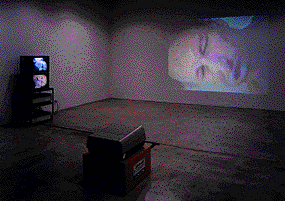
 video - Images recorded on videotape
or on optical disc to be
viewed on television screens, or
the medium through which
these images are recorded and displayed.
video - Images recorded on videotape
or on optical disc to be
viewed on television screens, or
the medium through which
these images are recorded and displayed.
Examples:

Nam June Paik (Korean-American, 1932-2006), Global
Groove, 1973, photograph
of a video screen / still from 3/4 inch color videotape, sound,
30 minutes, Museum of Modern Art, New York. Nam June Paik pioneered
in this medium in the
early 1960s.
.jpg)
Nam June Paik, Untitled, 1993, player piano, fifteen televisions, two cameras, two laser disk players, one electric light and light bulb, and wires; overall approximately 8 feet 4 inches x 8 feet 9 inches x 48 inches (254 x 266.7 x 121.9 cm), including laser disk player and lamp, Museum of Modern Art, New York.

Nam June Paik, Megatron, 1995, Guggenheim Museum, NY.
Jud Yalkut (American, 1938-) and Nam June Paik, Videotape Study No. 3, 1967-69, videotape, black-and-white, sound, 4 minutes, courtesy of Electronic Arts Intermix, NY.
Peter Campus (American, 1937-), Prototype for Interface, 1972, video camera, monitor, and glass, dimensions variable, collection of the artist.

Bruce Nauman (American, 1941-), Good Boy Bad Boy, 1985, color video and
monitors, installation,
Tate Gallery, London.

Bruce Nauman, Violent Incident, 1986, video, 200.0
x 250.0 x 90.0 cm, installation, Tate Gallery, London.
![]()

Bruce Nauman, Raw Material: Brrr, 1990, Guggenheim
Museum, NY.
Steina and Woody Vasulka (American, Steina Vasulka 1940-, Woody Vasulka 1937-), Calligrams, 1970, videotape, black-and-white, silent, 12 minutes.

"Gilbert and George" Gilbert Proesch
and George Passmore (English, 1943- and 1942-), In the Bush, 1972, video installation,
Tate Modern, London. See collaboration.

"Gilbert and George" Gilbert Proesch
and George Passmore, A Portrait of the Artists as Young Men,
1972, video installation, Tate Gallery, London. See self-portrait.
Ann Hamilton (American, 19..-), Untitled (ear/water), Untitled (mouth/water), Untitled (neck/water), Untitled (mouth/stones), 1993, four videos, each 30-minute video disk, LCD monitor with color toned image, and laser disk player, 9 1/2 x 17 x 3/16 inches (24.1 x 43.2 x 2.1 cm), edition: 6/9, Museum of Contemporary Art, Chicago.
Gary Hill (American, 1951-), Inasmuch as it is Always Already Taking Place, 1990, 16 channel video installation (NTSC, black-and-white, sound) with 16 modified video monitors, synchronizer, and niche, collection of the artist. Sixteen picture tubes in various sizes are loosely arrayed in a jumble, and housed within a deep horizontal alcove at chest level. Each screen displays an image of a portion of the artist's body — an upturned ear, a curled spine, a heaving chest — magnified and bathed in a soft, blue glow. The spare movements of each bodily fragment are accompanied by the gentle sounds of rustling paper, hushed phrases, and the rubbing of skin, repeating endlessly in a closed loop. See self-portrait.
Bill Viola (American, 1951-), Room for St. John of the Cross, 1983, video installation, ed. of 1, dimensions variable, Museum of Contemporary Art, Los Angeles.
Bill Viola, City of Man, 1989, video installation, three projections, Guggenheim Museum, NY.
Bill Viola, The Tree of Knowledge, 1997, video and computer, 168 x 144 x 1080 inches (430 x 368.6 x 2764.8 cm), collection of the artist; courtesy James Cohan Gallery, New York and Anthony d`Offay Gallery, London; produced by the ZKM Institute for Visual Media, Karlsruhe, Germany; animation, Bernd Linterman using xFrog software; laser position tracking, Andre Bernhardt.

Tony Oursler (American, 1957-), MMPI (Self-Portrait in Yellow), 1996,
video installation with
video projector, VCR, video tape, small cloth figure and metal chair, Milwaukee Art Museum,
WI. MMPI stands for the Minnesota Multiphasic Personality Inventory,
a diagnostic tool developed in the 1950s as a test for mental
health. It is based on the discovery that individuals with similar
mental disorders frequently answer the same questions in similar
ways. A projection of
the artist's head is seen pinned beneath the overturned chair,
as he answers one of the test's questions after another. See
self-portrait.
Paul Pfeiffer (American, 1966-), Fragment of a Crucifixion (After Francis Bacon), 1999, digital video loop, DVD player, miniature projector, and metal armature; image 3 x 4 inches; overall, including cables: 20 x 5 x 20 inches (50.8 x 12.7 50.8 cm), Whitney Museum of American Art, NY.
Matthew Barney (American, 1967-), Drawing Restraint 7, 1993, video monitors, laserdisc players, silent color laserdiscs, steel, plastic, and fluorescent lighting fixture; room dimension, 120 x 180 x 264 inches (304.8 x 457.2 x 670.6 cm), Whitney Museum of American Art, NY.
![]()
Kristin Lucas (American, contemporary), 5 Minute Break, 2001, two-channel video installation, 4:35 minutes, Museum of Modern Art, NY. "In Kristin Lucas’s video installation 5 Minute Break, a female avatar roams the World Trade Center’s sub-basement. A benign version of the popular video game and film character Lara Croft, the animated figure negotiates an underground maze of empty stairwells, faded graffiti, hulking machinery, and discarded trash. She is in a passive, idle mode, as if a video game player has momentarily left the control console."

Also see analog, art careers, aspect ratio, digital image, filter, iconoscope, monitor, movement, MPEG, music, new media, pan, panning shot, puppetry, theater, tilt, tracking shot, wide-angle lens, wide-angle shot, and zooming.
https://inform.quest/_art